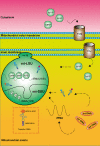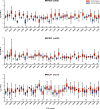Potential of Mitochondrial Ribosomal Genes as Cancer Biomarkers Demonstrated by Bioinformatics Results
- PMID: 35719986
- PMCID: PMC9204274
- DOI: 10.3389/fonc.2022.835549
Potential of Mitochondrial Ribosomal Genes as Cancer Biomarkers Demonstrated by Bioinformatics Results
Abstract
Next-generation sequencing and bioinformatics analyses have clearly revealed the roles of mitochondrial ribosomal genes in cancer development. Mitochondrial ribosomes are composed of three RNA components encoded by mitochondrial DNA and 82 specific protein components encoded by nuclear DNA. They synthesize mitochondrial inner membrane oxidative phosphorylation (OXPHOS)-related proteins and participate in various biological activities via the regulation of energy metabolism and apoptosis. Mitochondrial ribosomal genes are strongly associated with clinical features such as prognosis and foci metastasis in patients with cancer. Accordingly, mitochondrial ribosomes have become an important focus of cancer research. We review recent advances in bioinformatics research that have explored the link between mitochondrial ribosomes and cancer, with a focus on the potential of mitochondrial ribosomal genes as biomarkers in cancer.
Keywords: apoptosis; bioinformatics; biomarker; cancer; energy metabolism; mitochondrial ribosome.
Copyright © 2022 Bao, Wang, Li, Gao, Zheng, Shen and Liu.
Conflict of interest statement
The authors declare that the research was conducted in the absence of any commercial or financial relationships that could be construed as a potential conflict of interest.
Figures



Similar articles
-
Abnormal Expression of Mitochondrial Ribosomal Proteins and Their Encoding Genes with Cell Apoptosis and Diseases.Int J Mol Sci. 2020 Nov 23;21(22):8879. doi: 10.3390/ijms21228879. Int J Mol Sci. 2020. PMID: 33238645 Free PMC article. Review.
-
Mitochondrial ribosomes in cancer.Semin Cancer Biol. 2017 Dec;47:67-81. doi: 10.1016/j.semcancer.2017.04.004. Epub 2017 Apr 23. Semin Cancer Biol. 2017. PMID: 28445780 Free PMC article. Review.
-
Nuclear MRP genes and mitochondrial disease.Gene. 2005 Jul 18;354:147-51. doi: 10.1016/j.gene.2005.03.026. Gene. 2005. PMID: 15908146 Review.
-
Blackout in the powerhouse: clinical phenotypes associated with defects in the assembly of OXPHOS complexes and the mitoribosome.Biochem J. 2020 Nov 13;477(21):4085-4132. doi: 10.1042/BCJ20190767. Biochem J. 2020. PMID: 33151299 Free PMC article. Review.
-
Ribosome Biogenesis and Cancer: Overview on Ribosomal Proteins.Int J Mol Sci. 2021 May 23;22(11):5496. doi: 10.3390/ijms22115496. Int J Mol Sci. 2021. PMID: 34071057 Free PMC article. Review.
Cited by
-
RNA binding protein: coordinated expression between the nuclear and mitochondrial genomes in tumors.J Transl Med. 2023 Jul 28;21(1):512. doi: 10.1186/s12967-023-04373-3. J Transl Med. 2023. PMID: 37507746 Free PMC article. Review.
-
MRPL13 enhances mitochondrial function and promotes tumor progression in ovarian cancer by inhibiting mPTP opening via SLC25A6.Cell Death Dis. 2025 Aug 21;16(1):634. doi: 10.1038/s41419-025-07953-x. Cell Death Dis. 2025. PMID: 40841355 Free PMC article.
-
Characterizing influence of rCHOP treatment on diffuse large B-cell lymphoma microenvironment through in vitro microfluidic spheroid model.Cell Death Dis. 2024 Jan 9;15(1):18. doi: 10.1038/s41419-023-06299-6. Cell Death Dis. 2024. PMID: 38195589 Free PMC article.
-
Mitochondrial Ribosomal Proteins and Cancer.Medicina (Kaunas). 2025 Jan 9;61(1):96. doi: 10.3390/medicina61010096. Medicina (Kaunas). 2025. PMID: 39859078 Free PMC article. Review.
-
Genome-Wide Characterization of Somatic Mutation Patterns in Cloned Dogs Reveals Implications for Neuronal Function, Tumorigenesis, and Aging.Genes (Basel). 2024 Jun 18;15(6):801. doi: 10.3390/genes15060801. Genes (Basel). 2024. PMID: 38927737 Free PMC article.
References
Publication types
LinkOut - more resources
Full Text Sources

